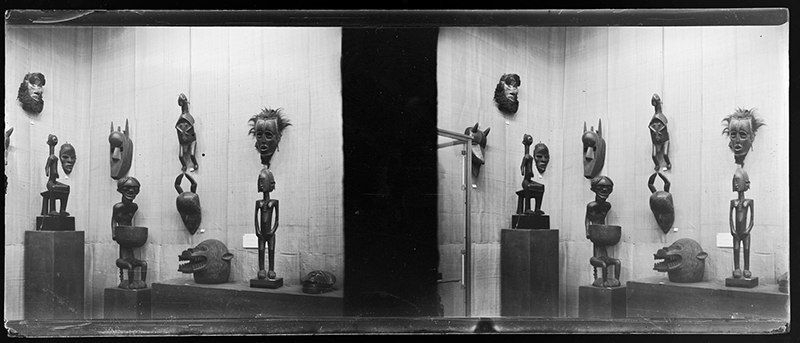Hilary Whitham Sánchez
Tristan Tzara’s Phenomenology of the Object between French Ethnography and the Harlem Renaissance

Unknown photographer, Société d’excursions des amateurs de photographie, installation view of Exposition d’art Africain et Océanien, Théâtre Pigalle, Paris, 1930. © Société Français de la Photographie
During the 1920s and 1930s, artists and critics increasingly emphasized what they saw as the radical qualities of African works, informed by their interest in international socialism and psychoanalysis, the institutionalization of ethnographic study, and expanding networks of Black intellectuals living on the continent and in the Diaspora. My research compares two exhibitions of African works in New York and Paris curated by the dean of the Harlem Renaissance, Alain Locke, and the founder and agent provocateur of Dada, Tristan Tzara, in 1927 and 1930, respectively. Locke’s framing of sub-Saharan African art as the racially based cultural inheritance of Black Americans placed African artists in a timeless past and ultimately instrumentalized them. In contrast, Tzara’s installation at the Théâtre Pigalle abjured geography, genre, style, and scale as organizing principles. Instead he enacted his call for placing African material cultures within their own art-historical trajectories, as outlined in his introductory remarks to the exhibition catalog. While Tzara’s personal collections included so-called decorative artworks favored by his Black contemporaries such as Locke, the display at the Théâtre Pigalle favored works more readily conflated with European formal categories, such as facial coverings for masquerade ensembles and large figurative reliquaries.
This work represents one chapter of my larger book project, provisionally titled “From Dada to Decolonization: The Idea of Africa and the Radical Past of Modernist Art,” which follows the African works in Tzara’s collections through multiple historical moments. From Tzara’s Galerie Dada in Zurich in 1917 to the Museum of Modern Art in New York in 1935, to the National Gallery of Rhodesia in what is today Harare in 1962, modernist critics of African and European descent reclassified African works from artifacts to art, isolating them from their original contextual meanings. Ultimately, I demonstrate how specific African artworks functioned as complex object experiences traveling through different but overlapping circuits, adhering to distinct but related definitions of value. Considering the role of African works in the exhibitions and performances of artists living and working along the Black Atlantic across six decades of the 20th century, “From Dada to Decolonization” thus presents a more rigorous and nuanced global history of the art of the avant-garde.
Hilary Whitham Sánchez will be assistant professor of Afro-Atlantic art history and museum studies at Purchase College, State University of New York, in fall 2022.
